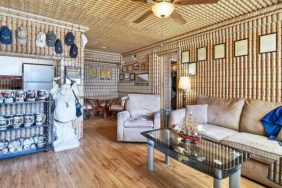Artwork: George Condo. Confrontation | Installation view Museum Berggruen, Nationalgalerie, Staatliche Museen zu Berlin | © Succession Picasso / VG Bild-Kunst, Bonn 2016 | Photo: Timo Ohle
George Condo, who catapulted to pop-culture fame after creating five different covers for the Kanye West album “My Beautiful Dark Twisted Fantasy” has always been a prince of the contemporary art scene. Born in Concord, New Hampshire, in 1957, Condo emerged as a leading artist from the 1980s East Village scene. He had invented “Artificial Realism,” a concept entirely his own, where he painted portraits of imaginary characters in the styles of Old Masters. It was a tongue-in-chic sensibility that immediately hit home, bridging the divide between the past and the present with a graceful hand and a playful eye.
Also: Pop and Performance Art Progenitor Yves Klein Returns to the World Stage
So it would be wholly natural for Condo to delve beyond the charming, quirky, and sometimes disturbing specters of his mind and delve wholly into the realm creating visual conversations the great masterworks of an earlier time. In George Condo: Confrontation, currently on view at Museum Berggruen, Berlin, through March 12, 2017, he does just this, showing his paintings alongside a series of iconic works by Paul Cézanne, Pablo Picasso, Henri Matisse, Paul Klee, and Alberto Giacometti and creating a dialogue that bridges the present with the past.

George Condo, Woman with Cross, 2004, Oil on canvas, 40.6 x 30.5 cm. Collection of the artist, New York. Courtesy Sprüth Magers and Skarstedt © VG Bild-Kunst, Bonn 2016 Photo: © George Condo 2016

Pablo Picasso, Seated Harlequin, 1905. Water colour and ink on cardboard, 57.2 x 41.2 cm. Staatliche Museen zu Berlin, Nationalgalerie, Museum Berggruen bpk/Nationalgalerie, SMB, Museum Berggruen / Jens Ziehe © Succession Picasso / VG Bild-Kunst, Bonn 2016
“It’s about putting things together and seeing how they react to one another. Whereas a dialogue is a more placid, almost prosaic platform for discussion. One has dialogues every day. I could have a dialogue every day with the lady down the street who’s selling cupcakes. But if I say to the cupcake lady, ‘Something is wrong with the frosting. Why is it blue?’ – suddenly we’re having more of a confrontation. And then it’s memorable!” Condo explains.
But for Condo, the idea of “confrontation” is not inherently antagonistic or hostile to a subject outside himself. He is no arguing, per se, with these artists so much as he is reflecting on his own interior world. Condo reveals, “It’s not simply to have a confrontation with other artists, it’s about the idea that I make my work in a confrontation with myself and I’m confronting my demons, my depressions, my happiness, my existence. I’m confronting this as an artist and I want to get the most out of who I am. I only can do this by confrontation.“
For Condo, the act of engagement bridges the interior and exterior worlds, the past and the present, and the nature of art itself. For artists who explore the edges of existence, both in terms of content and context, the avant-garde is always just ahead of where we are now. Condo, whose work has moved from the world of fine art to the mainstream, must continuously push the boundaries to stay ahead of the curve.
In this way, the artists and works he has chosen for Confrontation were once at the very cutting-edge of art. In light of where things have gone over the past century, they now possess a quaint, old-school charm. The shock of the new has completely worn off and in its place is a vernacular that has become associated with the highest traditions of modern art. With Confrontation, Condo restores a bit of the shock, reminding us that art is a conversation that never stops.

Henri Matisse, Vegetable Elements, 1947. Gouache découpée on canvas, 65 x 50 cm. Staatliche Museen zu Berlin, Nationalgalerie, Museum Berggruen bpk/Nationalgalerie, SMB, Museum Berggruen / Jens Ziehe © Succession H. Matisse / VG Bild-Kunst, Bonn 2016

George Condo, Telepoche Cut-Out, 1989, Detail, Öl und Collage auf Leinwand, Sammlung des Künstlers, New York / Courtesy Sprüth Magers und Skarstedt © VG Bild-Kunst, Bonn 2016, Foto: © George Condo 2016
Miss Rosen is a New York-based writer, curator, and brand strategist. There is nothing she adores so much as photography and books. A small part of her wishes she had a proper library, like in the game of Clue. Then she could blaze and write soliloquies to her in and out of print loves.





